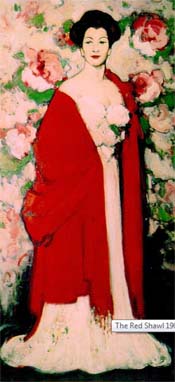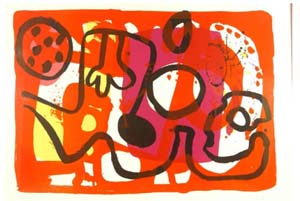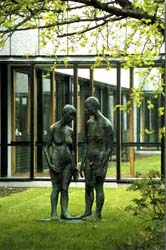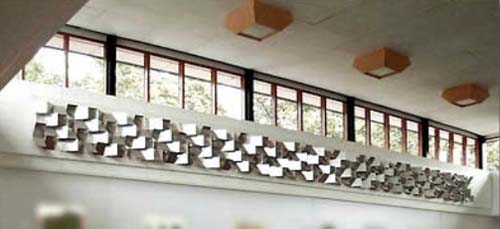
The University Art Collection is open to the public. Admission is free.

The Art Collection at the University of Stirling is a varied one comprising paintings, sketches, tapestries, sculpture and silver. Its focus is Scottish contemporary art.
The majority of works are in the Pathfoot Building with sculpture on display all around the campus.
Spend a few hours on the most beautiful campus in the country and visit Stirling University Art Collection, one of the finest and least well known art collections in the country. This hidden treasure is contained within the Pathfoot building, an outstanding example of post-war Modernist architecture that sits perfectly on the landscape of the old Airthrey estate.
Comprising over 500 works including paintings, sketches, tapestries, sculpture and silver, much of the work was purchased in the late Sixties and the Seventies and there is a fine collection from that period, with several examples of the work of Patrick Heron, Terry Frost and Graham Sutherland.
The University has received two large and valuable gifts during the Collection's history. The first being a gift of fourteen works by the Scottish Colourist painter J.D. Fergusson that was presented to Stirling by the artist's widow Margaret Morris; the second being a gift of fifteen paintings and three sculptures given to the University in 1997 as part of the Scottish Arts Council Bequest.

When Stirling University was founded, the first Principal Tom Cotterell, was determined that Art should be part of the everyday experience at the University. It is his philosophy that has been driving and inspiring the collection ever since. The majority of Stirling University Art Collection can be found in the Pathfoot Building although art and sculpture are dotted all around the campus. Art is still a part of everyone's lives at Stirling University whether you are studying here or simply visiting.
Although most of the works are concentrated in the Pathfoot Building with its light airy courtyards and multi level Concourse Gallery, one of the special areas of collecting interest is in the field of outdoor sited sculpture. The ultimate aim is to provide a Sculpture Trail through the beautifully landscaped grounds for visitors as a follow up to viewing the Pathfoot Gallery. A proportion of the works are displayed in Halls of Residence, the University Library, the Courtroom Building and other easily accessible areas.
The Lower Concourse Gallery contains works by the Scottish Colourist artist John Duncan Fergusson. The light and airy concourse gallery provides an excellent environment for showing these works. The collection of fourteen of his paintings was chosen to represent all periods of his life from his very early Bazaar in Tangiers, c.1897 to A Bridge on the Kelvin, 1942. Our collection includes some of his finest work and includes the seminal painting Rhythm, 1911.
The Gallery also contains temporary exhibitions as well as works such as Martyr by Sir Robin Philipson and sculpture by George Wyllie. It is intended that each of the 17 courtyards at the Pathfoot Building will in time be dedicated to an individual sculptor. From the lower concourse you can view Barbara Hepworth's magnificent Archaen and Richard Robbins' delightful Adam and Eve.
Proceeding up the first flight of stairs, you will find Henry Clyne's Opening Bend suspended above the stairwell. Works at this upper level include Ferguson paintings Bathers Noon and Portsmouth Docks as well as pieces by David Michie, John Bellany and Fionna Carlisle.
The double storied assembly of the Crush Hall is a light open area with multi purpose usage but the high white walls provide a perfect space for some of the collection's larger abstract works which have an immense visual impact. Polyphony by Diane Tulloch , Wanderer by Andrew Hay and Are you Experienced by Geoffrey Cervantes are hung here. In the Courtyard at the far end of the Crush Hall there are several pieces of sculpture by Lotte Glob.
Moving towards the upper gallery you will find a courtyard designed by Willie Rodger's son Guy Rodgers for the 2007 exhibition Willie Rodgers and Family. In the four corners of the courtyard there are four granite stones which represent the number of children and grandchildren in the Rodgers family. There are also three oystercatcher sculptures undertaken by Helen Denerley. These sculptures are located in this courtyard because this is the courtyard where a single pair of oystercatchers nest and breed every year. There is also a poem on the glass called oystercatcher written by Robin Rodger and a poem by Liz Lochhead as a tribute to Willie Rodger.

Pathfoot's Upper Concourse is dominated by works by Willie Rodger including Look, Not again and Sisyphus. The Art Collection continues along the J Corridor whose walls are adorned with the works of animator Norman McLaren. The University also holds the Norman McLaren archive among its collections.
Stirling University art collection is open to the public 7 days a week and there is a regularly changing schedule of exhibitions
Open
9am to 5pm (weekdays)
11am to 3pm (weekends)
Closed
24th December to 7th January

Telephone 01786 466050
email: art.collection@stir.ac.uk
When you are visiting the collection, take a good look at the Pathfoot building around you. Pathfoot is an outstanding example of post-war Modernist architecture and a building of international significance. Robert Matthew, Johnson-Marshall and Partners, were among the leading architects' practices in Scotland dominating the architectural scene from the late 1950s onward. With Robert Matthew as their founder, and with later influential partners such as John Richards they produced some of the most highly regarded buildings of the post-war period in Scotland, the UK and abroad.
The relationship with the landscape and the aesthetics of the building were highly influenced by contemporary Danish design, most notably the Louisiana museum of Modern Art by Jorgen Bo and Wilhelm Wohlert.

Sympathetic later extension has not altered the original character of the building, and extensions have been carefully designed with detailing derived from the original building. The building exploits its natural setting with a discreet form and carefully controlled internal and external vistas.
Find out more about Stirling University
The tradition of collecting art goes back to the founding of the University in 1967 when Professor Tom Cottrell was the first Principal. A scientist by training, he came from an artistic background and had very clear ideas about art and its place in society. He felt that art should be part of the everyday experience at the University and it is his philosophy that has been driving and inspiring the university to keep on collecting and showing exciting art to the public ever since.
It was this philosophy that prompted the early decision to budget for works of art to enhance the developing campus and 1% of the cost of each new building was earmarked for art to decorate it in the first phase of University building.
In these early days site specific works were commissioned and an excellent example of this is the wall mounted steel sculptural panel by Mary Martin which was originally commissioned for the Pathfoot Dining Room and now hangs in the Crush Hall

Pathfoot was the first building designed and built for the University of Stirling and from its inception was meant to house all the new institution's needs before the rest of the campus, the social and teaching buildings and the rest of the residences, was completed. Pathfoot was completed in time for the opening semester in 1967, less than a year after ground was broken. Part of its success was due to the unique prefabricated building system developed by the practice which could be assembled in any order and the floor was not dependent on the framing system. This innovation was a milestone in construction terms for the Edinburgh practice and would influence their design and building process at Aberdeen and Edinburgh airports.
Stirling University was the only "New University" to be built in Scotland and was part of the wider government agenda to develop and expand tertiary education near small urban centres across the UK. Stirling was chosen along with Sussex, Warwick, Kent, York, Essex, Lancaster, East Anglia, all of which were set in parkland. The planning and design of Stirling University benefited from being conceived in the later 1960s once lessons of the first university schemes had been learned. For example, at Stirling, the perceived elitist agenda of the first schemes modelled on the Oxbridge formula of cloisters and segregated social and departmental areas (as pre-conceived by a master-plan), had expanded to a completely flexible, non-rigid set of buildings which could accommodate shifting patterns of inter-departmental teaching and allow for more casual social interaction among the student population.
© in stirling. All rights reserved.